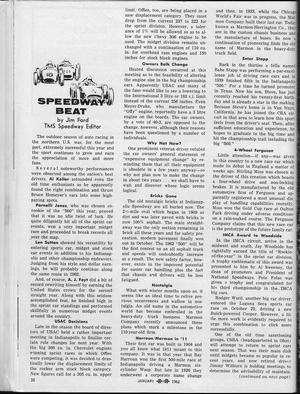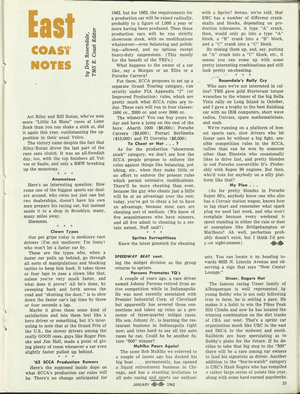|
By accessing/using The Crittenden Automotive Library/CarsAndRacingStuff.com, you signify your agreement with the Terms of Use on our Legal Information page. Our Privacy Policy is also available there. |

Speedway Beat
|
|---|
|
|
Speedway Beat
Jim Ford, TMS Speedway Editor
Today's Motor Sports
January 1962
The outdoor season of auto racing in the northern U.S. was, for the most part, extremely successful this year and the sport continues to grow and earn the appreciation of more and more fans.
Several noteworthy performances were observed among the nation's best drivers.
Al Keller astounded even the old time enthusiasts as he apparently found the right combination and thrust Bruce Homeyer's cars into some high-paying spots.
Parnelli Jones, who was chosen co-rookie of the "500" this year, proved that it was no idle twist of luck. He quite diligently hit all of the sprint car events, won a very important midget race and proceeded to break records all over the map.
Len Sutton showed his versatility by entering sports car, midget and stock car events in addition to his Indianapolis and other championship endeavors. Judging from this style and dollar earnings, he will probably continue along the same route in 1962.
And, of course,
A.J. Foyt did a bit of record rewriting himself by earning the United States crown for the second straight year. Along with this seldom-accomplished feat, he finished high in the sprint car standings and performed skillfully in numerous midget events around the country.
USAC Decisions
Late in the season the board of directors of USAC held a rather important meeting in Indianapolis to finalize certain rule changes for next year. With the big 366 cu. in. Chevrolet engines winning sprint races in which Offies were competing, it was decided to drastically lower the displacement limits of the rocket arm stock block category. New figures call for a 305 cu. in. upper limit. Offies, too, are being placed in a new displacement category. They must drop from the current 227 to 222 for the sprint division. However, a tolerance of 1% will be allowed so as to allow the new Chevy 306 engine to be used. The midget division remains unchanged with a continuation of 110 cu. in. for overhead cam engines and 150 inches for stock block engines.
Owners Balk Change
Heated discussion occurred at this meeting as to the feasibility of altering the engine size in the big championship cars. Apparently USAC and many of the fans would like to see a lowering to the International 3 litre or 183 c.i. limit instead of the current 256 inches. Even Meyer-Drake, who manufacture the "Offy" engine, reportedly have a 3 litre engine on the boards. The car owners, by a vote of 40-3, are opposed to the change, however, although their reasons have been questioned by a number of individuals.
Why Not Now?
One prominent veteran driver refuted the car owners' general statement of "expensive equipment change" by reminding them that
all their equipment is obsolete in a few years anyway—so why not plan now to make the change in about two years . . . we shall have to wait and discover whose logic seems logical.
Bricks Gone
The old nostalgic bricks at Indianapolis Speedway are all buried now. The 2½-mile oval which began in 1909 as dirt and was later paved with bricks is now 100% asphalt. The main straightaway was the only section remaining in brick all these years and for safety precaution, modern pavement finally won out in October. The 1962 "500" will be the first contest on an all-asphalt track and speeds will undoubtedly increase as a result. The new safety factor, however, exists in the improved potential for easier car handling plus the fact that chassis and drivers will be less fatigued.
Nostalgia
What with winter months upon us, it seems like an ideal time to relive previous occurrences and wallow in nostalgia. An old name in the automotive world has become embroiled in the heavy-duty truck business. Marmon Company recently announced these plans which mark a milestone in the 110-year-old firm.
Harroun/Marmon in '11
Their first car was built in 1904 and you all know what 1911 meant to this company. It was in that year that Ray Harroun won the first 500-mile race at Indianapolis driving a Marmon six-cylinder Wasp. But late in 1926 they underwent a corporate name change and then, in 1933, while the Chicago World's Fair was in progress, the Marmon Company built their last car. Today known as Marmon-Herrington Co., they are in the custom chassis business and the manufacture of buses. So now a continuation of pioneering finds the old name of Marmon in the heavy-duty truck field.
Enter Stapp
Back in the thirties a fella named Babe Stapp was performing a par-excellence job of driving race cars and in 1939 finished fifth in the Indianapolis "500." For a time he turned promoter in Texas. Now his son, Steve, has just recently reached his twenty-first birthday and is already a star in the making. Because Steve's home is in Van Nuys, California, he has joined the CRA circuit in that area to learn how this sport feels from the driver's seat. Then, after sufficient education and experience, he hopes to graduate to the big time and hit the championship trail including the big "500."
4-Wheel Ferguson
Little attention—if any—was given in this country to a new race car which made its debut in England a matter of weeks ago. Stirling Moss was chosen as the driver of this creation which boasts a four-wheel drive and non-locking brakes. It is manufactured by the old automotive firm of Ferguson and apparently registered a most unusual display of handling capabilities recently. Moss won the Gold Cup race at Oulton Park driving under adverse conditions on a rain soaked course. The Ferguson Company claims that this new race car is the prototype of the future family car.
IMCA Award to Woodside
In the IMCA circuit, active in the midwest and south, Jay Woodside has rightfully earned the title of "Rookie-of-the-year" in the sprint car division. A trophy emblematic of this award was presented to him by Al Sweeney, the dean of promoters and President of National Speedways. Pete Folse was given a trophy and congratulated for his third championship in the IMCA big cars.
Rodger Ward, another big car driver, entered the Laguna Seca sports car race on October 22, driving a new Buick-powered Cooper. However, a little more work is evidently required to urge this combination to click more successfully.
One of the old time sanctioning groups, CSRA (headquartered in Ohio) will attempt to return to sprint cars next season. That was their main dish until midgets became so popular in recent years, and now retired driver Jimmy Wilburn is holding meetings to determine the advisability of maintaining the midget division as the group returns to sprints.
Parsons Promotes TQ's
A couple of years ago, a race driver named Johnny Parsons retired from active competition while in Indianapolis. He was most recently associated with Premier Industrial Corp. of Cleveland but apparently has severed those connections and taken up reins as a promoter of three-quarter midget races. His son, Johnny Jr., is learning the restaurant business in Indianapolis right now, and tries hard to see all the auto races he can. Could he be another future "500" winner?
Muhlke Pours Again!
The same Bob Muhlke we referred to a couple of issues ago has docked his big boat . . . permanently, has opened a liquid refreshment business in Chicago, and has a standing invitation to all auto racing and sports car enthusiasts. You can locate it by heading towards 6025 Lincoln Avenue and observing a sign that says "New Center Lounge."
Unser, Rogers Hot
The famous racing Unser family of Albuquerque is well represented by young Bobby who is not only following true to form, he is setting a pace. He makes it a habit to win the Pikes Peak Hill Climbs and now he has located the winning combination on the dirt tracks of CRA out west. That's a sprint car organization much like URC in the east and IMCA in the midwest and south. Railbirds are busy speculating as to Bobby's plans for the future. If he decides to take that big step to the "500" there will be a race among car owners to land his signature as driver. Another addition to the "boy-to-watch" category is URC's Hank Rogers who has compiled a rather large series of points this year, along with some hard-earned paychecks.




















